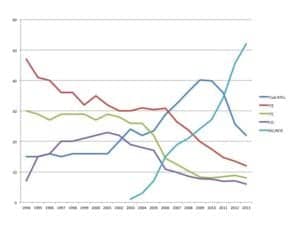Staff Standpoint | Hearing Review June 2014
By Karl Strom, Editor-in-Chief
Receiver-in-the-canal/ear (RIC/RITE) hearing aids continue to trend upward in usage and now constitute well over half (56.7%) of all hearing aids sold in the United States. In the first quarter of 2014, they accounted for 58.9% of all hearing aids in the commercial sector—up from 51.0% during the same period last year. Similarly, in the Department of Veterans Affairs (VA), 48.3% of units dispensed were RIC-type devices.

[Click on image to enlarge.] Figure 1. Estimated US hearing aid style utilization (in percent) from 1994 to 2013, extrapolated from HIA statistical data. HIA started tracking “external receiver” BTEs (ie, RIC/RITEs) in 2009; therefore, the data on traditional BTEs and RIC/RITE styles from 2003-2009 are HR estimates only.
Although RIC/RITE aids are custom-fit devices in the sense of an individualized acoustical fitting, most do not use a custom earmold. Several industry experts have pointed out that this leaves hearing aids more vulnerable to commoditization.
Will the pendulum swing the other way? RIC/RITE styles offer an array of advantages to the consumer and the professional. However, I have heard several discussions in convention hallways and lounges that point to the possibility that these devices are being overprescribed. And, no, this isn’t coming from the earmold suppliers! ITEs—and particularly deep-fitting CICs—do offer some distinct advantages that may be difficult to replicate (pinnae-effect and wind-noise algorithms aside).
We also have the interesting new technology of direct 3D ear scanning. Lantos Technologies (see the May 2012 Hearing Review Products, pgs 8-12) received FDA approval for its 3D ear scanning technology in March 2013, and GN’s Otoscan (based on 3DM technology which Hearing Review covered in July 2012, pgs 28-34) is expected to make its debut later this year. At least two other companies are involved in developing similar techology for ear scanning. When this technology is implemented, we may see for the first time the impact of true deep-fitting instruments on a wider scale than Phonak’s extended-wear Lyric. So it’s possible there may be a renaissance in ITE-style devices in the wings.
Original citation for this article: Strom KE. The RIC as a disruptive technology. Hearing Review. 2014;21(6):6.
CORRECTION: As pointed out by Natan Bauman, PhD, in a subsequent Letter to the Editor, the Vivatone hearing aid was introduced in 2004, not 2008 as originally stated in this article. The editor apologizes for the error. To see Dr Bauman’s letter and the editor’s response, click here.





